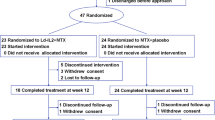Abstract
The aim of this study is to assess the efficacy of anakinra, a recombinant human interleukin 1 receptor antagonist, plus methotrexate (MTX) in patients with active rheumatoid arthritis (RA) refractory to MTX therapy. A total of 54 patients with active RA, who were taking MTX at a stable dosage, were randomized to receive daily subcutaneous injections of anakinra (80 mg) or placebo. Clinical outcomes were assessed every 4 weeks for 24 weeks by using the criteria of the American College of Rheumatology. After 24 weeks, more patients achieved clinical benefits as determined by the ACR20 improvement treated with anakinra plus MTX compared with MTX alone (64% vs. 17%, P = 0.004). In the anakinra group, an ACR50 response was observed in 38% and an ACR70 response in 17%. None of the patients treated with MTX alone achieved ACR50 or ACR 70 improvement. However, nine of 42 (21.4%) patients in the anakinra group, who showed therapeutic response initially, had secondary drug failure to anakinra therapy thereafter. A significant increase in mean DAS28 from baseline was found in the non-responders to anakinra compared with placebo (0.83 ± 1.38 vs. −1.28 ± 0.78, P < 0.001). Anakinra is effective in the treatment of patients with active RA by blocking IL-1. However, the efficacy of anakinra is soon lost in about one fifth of patients in spite of initial good response.


Similar content being viewed by others
References
Bresnihan B, Cobby M (2003) Clinical and radiological effects of anakinra in patients with rheumatoid arthritis. Rheumatology 42:ii22–ii28
Burger D, Dayer JM (2006) Is IL-1 a good therapeutic target in the treatment of arthritis? Best Pract Res Clin Rheumatol 20:879–896
Genovese MC, Cohen S, Moreland L et al (2004) Combination therapy with etanercept and anakinra in the treatment of patients with rheumatoid arthritis who have been treated unsuccessfully with methotrexate. Arthritis Rheum 50:1412–1419
Buch MH, Bingham SJ, Seto Y et al (2004) Lack of response to anakinra in rheumatoid arthritis following failure of tumor necrosis factor alpha blockade. Arthritis Rheum 50:725–728
Felson DT, Anderson JJ, Boers M et al (1995) American College of Rheumatology. Preliminary definition of improvement in rheumatoid arthritis. Arthritis Rheum 38:727–735
Weinblatt ME, Keystone EC, Furst DE et al (2003) Adalimumab, a fully human anti-tumor necrosis factor monoclonal antibody, for the treatment of rheumatoid arthritis in patients taking concomitant methotrexate. The ARMADA Trial. Arthritis Rheum 48:35–45
Potter C, Hyrich KL, Tracey A et al (2009) Association of rheumatoid factor and anti-cyclic citrullinated peptide positivity, but not carriage of shared epitope or PTPN22 susceptibility variants, with anti-tumor necrosis factor response in rheumatoid arthritis. Ann Rheum Dis 68:69–74
Johnsen AK, Plenge RM, Butty V et al (2008) A broad analysis of IL1 polymorphism and rheumatoid arthritis. Arthritis Rheum 58:1947–1957
Anderson AE, Isaacs JD (2008) Tregs and rheumatoid arthritis. Acta Reumatol Port 33:17–33
Lawson CA, Brown AK, Bejarano V et al (2006) Early rheumatoid arthritis is associated with a deficit in the CD4+CD25+high regulatory T cell population in peripheral blood. Rheumatology 45:1210–1217
van Amelsfort JM, van Room JA, Noordegtaaf M et al (2007) Proinflammatory mediator-induced reversal of CD4+CD25+ regulatory T cell-mediated suppression in rheumatoid arthritis. Arthritis Rheum 56:732–742
Brinster C, Shevach EM (2008) Costimulatory effects of IL-1 on the expansion/differentiation of CD4+CD25+Foxp3+ and CD4+CD25+Foxp3− T cells. J Leukoc Biol 84:480–487
Funding
This study was supported in part by the grants from National Natural Science Foundation of China (No. 30972729) and Shanghai Natural Science Foundation (No. 09ZR1410700).
Authors' contributions
Dr. Bao carried out the clinical studies and drafted the manuscript. Dr. Yue, Dr. Liu, Dr. Zhang, and Dr. Zhou participated in the follow-up of the study and collected data. Dr. Xu conceived of the study, participated in its design and coordination, and helped to draft the manuscript. Dr. Dai participated in the design of the study, performed the statistical analysis, and helped to revise the manuscript. All authors read and approved the final version to be published.
Disclosures
None.
Author information
Authors and Affiliations
Corresponding authors
Rights and permissions
About this article
Cite this article
Bao, J., Yue, T., Liu, W. et al. Secondary failure to treatment with recombinant human IL-1 receptor antagonist in Chinese patients with rheumatoid arthritis. Clin Rheumatol 30, 697–701 (2011). https://doi.org/10.1007/s10067-010-1654-5
Received:
Revised:
Accepted:
Published:
Issue Date:
DOI: https://doi.org/10.1007/s10067-010-1654-5




